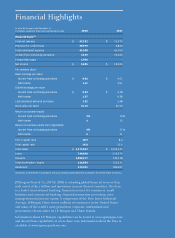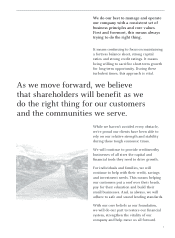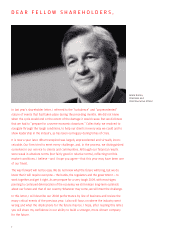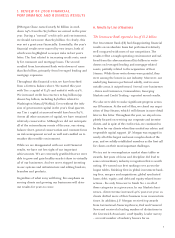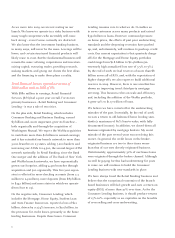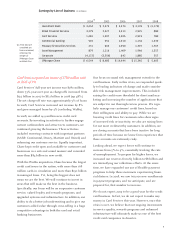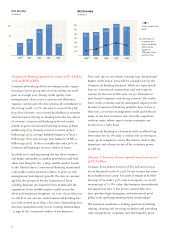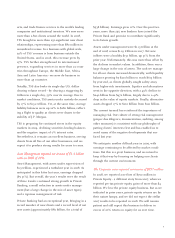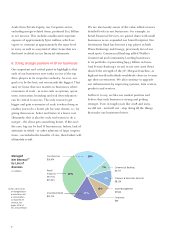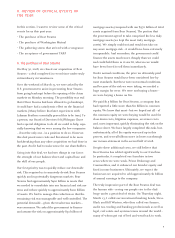JP Morgan Chase 2008 Annual Report Download - page 11
Download and view the complete annual report
Please find page 11 of the 2008 JP Morgan Chase annual report below. You can navigate through the pages in the report by either clicking on the pages listed below, or by using the keyword search tool below to find specific information within the annual report.9
II. REVIEW OF CRITICAL EVENTS OF
THE YEAR
In this section, I want to review some of the critical
events for us this past year:
• The purchase of Bear Stearns
• The purchase of Washington Mutual
• The gathering storm that arrived with a vengeance
• The acceptance of government TARP
A. The purchase of Bear Stearns
On May 30, 2008, we closed our acquisition of Bear
Stearns – a deal completed in record time under truly
extraordinary circumstances.
Over the weekend of March 15, we were asked by the
U.S. government to assist in preventing Bear Stearns
from going bankrupt before the opening of the Asian
markets on Monday morning. The possibility was real
that if Bear Stearns had been allowed to go bankrupt,
it could have had a cataclysmic effect on the financial
markets. (Many believe that later experiences with
Lehman Brothers essentially proved this to be true.) To
a person, our Board of Directors felt JPMorgan Chase
had a special obligation to do all we could to help, espe-
cially knowing that we were among the few companies
– if not the only one – in a position to do so. However,
this deal posed more risks and threatened to be more
backbreaking than any other acquisition we had done in
the past. And it had to make sense for our shareholders.
Going into this deal, we had two things in our favor:
the strength of our balance sheet and capital base and
the skill of our people.
Our first priority was to quickly reduce our downside
risk. This required us to massively de-risk Bear Stearns
quickly and in potentially dangerous markets. Bear
Stearns had approximately $400 billion in assets that
we needed to consolidate into our financial and risk sys-
tems and reduce quickly to approximately $200 billion
of assets. We had to manage this reduction so that the
remaining risk was manageable and well-controlled. The
potential downside – given the treacherous markets –
was enormous. We asked the government to finance
and assume the risk on approximately $30 billion of
mortgage assets (compared with our $370 billion of total
assets acquired from Bear Stearns). The portion that
the government agreed to take comprised the less risky
mortgage assets (we kept the most risky mortgage
assets). We simply could not and would not take on
any more mortgage risk – it would have been extremely
irresponsible. And remember, the government could
finance the assets much more cheaply than we could
and could hold them as it saw fit, whereas we would
have been forced to sell them immediately.
Under normal conditions, the price we ultimately paid
for Bear Stearns would have been considered low by
most standards. But these were not normal conditions,
and because of the risk we were taking, we needed a
huge margin for error. We were not buying a house –
we were buying a house on fire.
We paid $1.5 billion for Bear Stearns, a company that
had reported a little more than $11 billion in common
equity. We knew that most – but we hoped not all – of
the common equity we were buying would be used for
close-down costs, litigation expenses, severance costs
and, most important, quickly eliminating the risk on the
balance sheet. We have largely completed this task, but,
unfortunately, all of the equity was used up in this
process, and several billions more in losses ran through
our income statement in the second half of 2008.
Despite these additional costs, we still believe that
Bear Stearns has added significantly to our franchise.
In particular, it completed our franchise in two
areas where we were weak, Prime Brokerage and
Commodities, and it enhanced our broader equity and
fixed income businesses. Ultimately, we expect the
businesses we acquired to add approximately $1 billion
of annual earnings to the company.
The truly impressive part of the Bear Stearns deal was
the human side – seeing our people rise to the chal-
lenge under a great deal of strain. On Thursday night,
March 13, I called our investment banking heads, Steve
Black and Bill Winters, who then called our finance,
audit, tax, trading and banking professionals as well as
legal, real estate and systems teams around the world –
many of whom got out of bed and went back to work.


